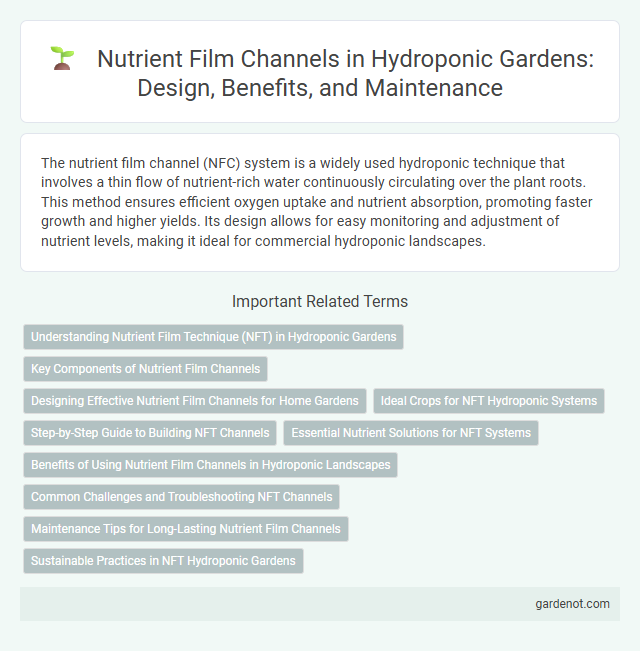The nutrient film channel (NFC) system is a widely used hydroponic technique that involves a thin flow of nutrient-rich water continuously circulating over the plant roots. This method ensures efficient oxygen uptake and nutrient absorption, promoting faster growth and higher yields. Its design allows for easy monitoring and adjustment of nutrient levels, making it ideal for commercial hydroponic landscapes.
Understanding Nutrient Film Technique (NFT) in Hydroponic Gardens
Nutrient Film Technique (NFT) in hydroponic gardens utilizes a shallow stream of nutrient-rich water continuously flowing over the roots, promoting efficient oxygen and nutrient uptake. This method enhances plant growth by maintaining a thin film of solution that ensures constant root exposure to oxygen while delivering essential minerals. NFT systems require precise flow control and regular monitoring to prevent root drying and nutrient imbalances, making them ideal for crops with fast growth cycles like leafy greens.
Key Components of Nutrient Film Channels
Nutrient Film Channels (NFC) systems rely on shallow, sloped channels where a thin film of nutrient-rich water continuously flows over plant roots, maximizing oxygen exposure and nutrient uptake. Key components include the channel itself, typically made from PVC or aluminum for durability and ease of cleaning, a reservoir tank to hold the nutrient solution, and a pump to maintain consistent flow and circulation. Additionally, end caps, flow regulators, and support structures are essential for ensuring optimal channel stability and nutrient distribution in hydroponic landscapes.
Designing Effective Nutrient Film Channels for Home Gardens
Designing effective Nutrient Film Channels (NFC) for home gardens involves optimizing channel slope and flow rate to ensure a consistent thin film of nutrient-rich water reaches plant roots, promoting efficient nutrient uptake. Selecting materials like food-grade PVC and incorporating modular designs enhances durability and scalability, while integrating proper aeration prevents root hypoxia. Precise control of nutrient solution composition, pH balance, and circulation timing maximizes plant growth and yield in hydroponic systems.
Ideal Crops for NFT Hydroponic Systems
Lettuce, spinach, and herbs such as basil thrive in Nutrient Film Technique (NFT) hydroponic systems due to their shallow root structures and quick growth cycles. Strawberries and certain leafy greens also benefit from consistent nutrient flow and oxygenation provided by NFT channels. Crops demanding extensive root support or heavy fruiting are less suitable for this method compared to these ideal species.
Step-by-Step Guide to Building NFT Channels
Constructing Nutrient Film Technique (NFT) channels requires selecting lightweight, durable materials such as PVC or food-grade plastic to form shallow channels with a slight slope for continuous nutrient flow. Installing a reservoir, submersible pump, and tubing ensures a consistent nutrient film circulates over the plant roots, promoting oxygenation and efficient nutrient uptake. Proper channel spacing, typically 3 to 6 inches apart, and easy access for planting and maintenance optimize growth conditions within hydroponic systems.
Essential Nutrient Solutions for NFT Systems
Essential nutrient solutions for Nutrient Film Technique (NFT) systems provide a balanced mix of macronutrients like nitrogen, phosphorus, potassium, calcium, magnesium, and sulfur to support optimal plant growth. These solutions must also contain critical micronutrients such as iron, manganese, zinc, copper, molybdenum, and boron, ensuring efficient nutrient uptake in the thin film of circulating water. Maintaining precise pH and electrical conductivity (EC) levels in the nutrient film is vital for maximizing nutrient availability and sustaining healthy hydroponic crop development.
Benefits of Using Nutrient Film Channels in Hydroponic Landscapes
Nutrient film channels (NFT) provide a continuous flow of nutrient-rich water across plant roots, ensuring efficient nutrient uptake and oxygen access, crucial for maximizing growth in hydroponic landscapes. This system reduces water and nutrient waste by recirculating solutions, promoting sustainability and cost-effectiveness. The shallow flow design minimizes root diseases and supports dense plant spacing, enhancing overall yield and space utilization in hydroponic setups.
Common Challenges and Troubleshooting NFT Channels
Nutrient Film Technique (NFT) channels in hydroponic landscapes commonly face challenges such as nutrient imbalances, channel blockages, and inconsistent water flow, which can lead to poor plant growth and root diseases. Troubleshooting involves regularly monitoring nutrient solution concentration with EC meters, ensuring balanced pH levels between 5.5 and 6.5, and inspecting channels for debris or algae buildup that may restrict flow. Maintaining optimal nutrient film thickness and cleaning NFT channels frequently helps prevent oxygen depletion and root hypoxia, promoting healthy plant development.
Maintenance Tips for Long-Lasting Nutrient Film Channels
Regularly inspect nutrient film channels for debris and algae to prevent blockages and ensure optimal water flow in hydroponic systems. Use a mild bleach solution or hydrogen peroxide to clean channels without damaging their surface or plants. Schedule routine flushing of the channels to remove nutrient buildup, maintaining efficient nutrient delivery for healthy plant growth.
Sustainable Practices in NFT Hydroponic Gardens
Nutrient Film Technique (NFT) hydroponic gardens optimize water and nutrient use by maintaining a thin film of nutrient solution flowing over plant roots, reducing waste and promoting efficient uptake. Sustainable practices in NFT systems include recycling nutrient solutions, using organic nutrient sources, and monitoring pH and electrical conductivity to minimize environmental impact. Integrating renewable energy for pumps and employing biodegradable channels further enhances the eco-friendliness of NFT hydroponic gardens.
Nutrient film channel Infographic

 gardenot.com
gardenot.com